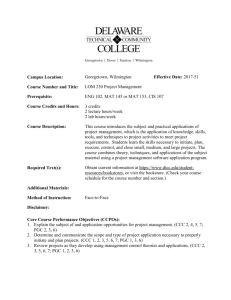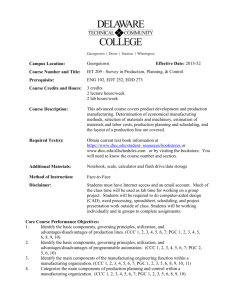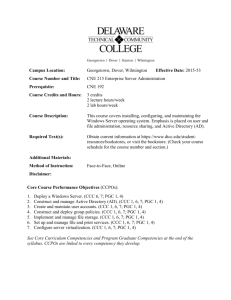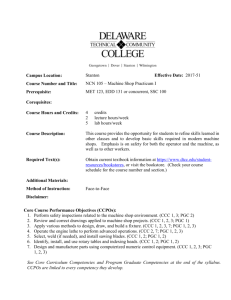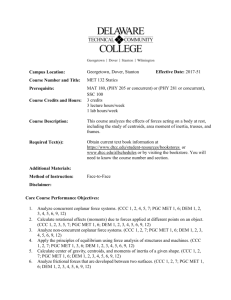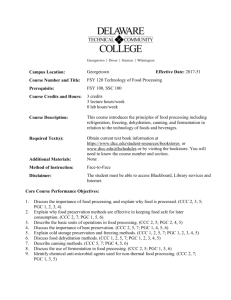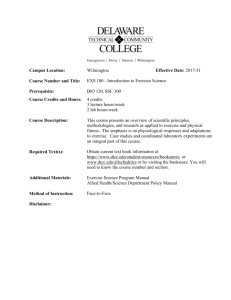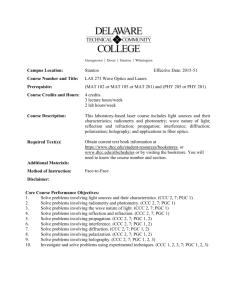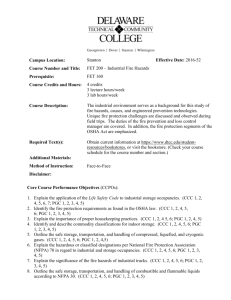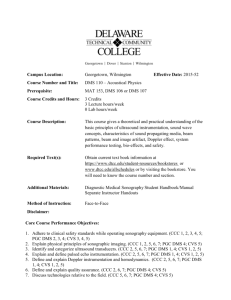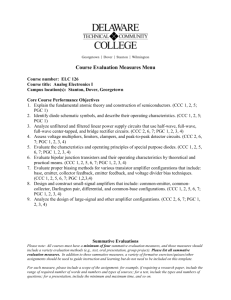CMT 234 201751 - E
advertisement
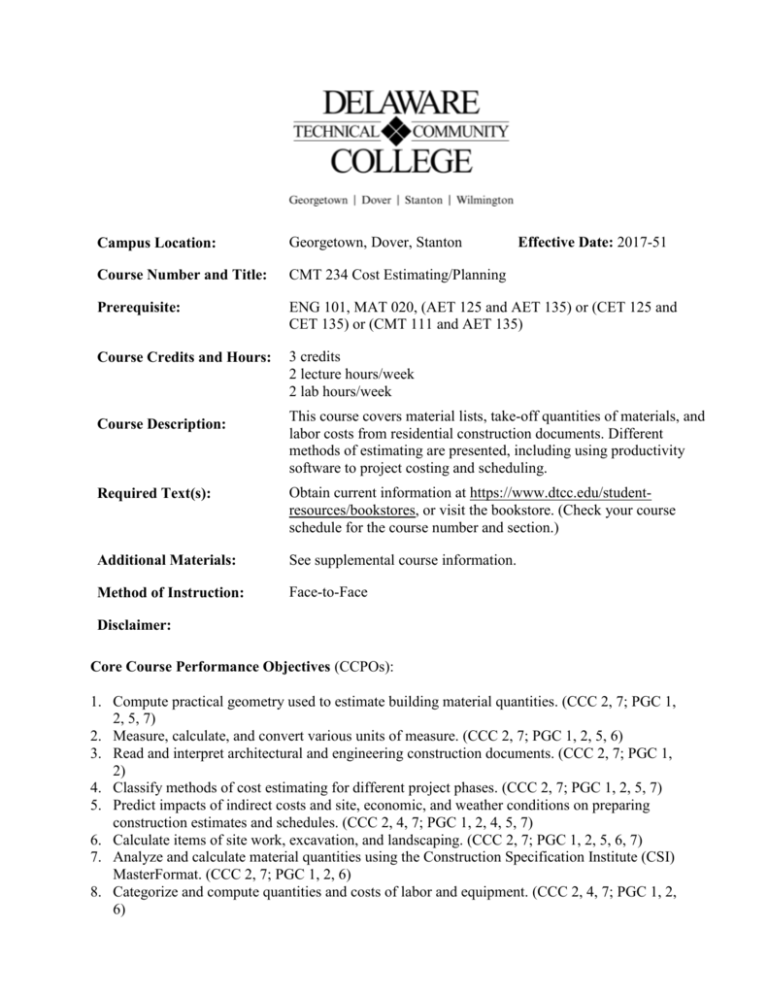
Campus Location: Georgetown, Dover, Stanton Course Number and Title: CMT 234 Cost Estimating/Planning Prerequisite: ENG 101, MAT 020, (AET 125 and AET 135) or (CET 125 and CET 135) or (CMT 111 and AET 135) Course Credits and Hours: 3 credits 2 lecture hours/week 2 lab hours/week Course Description: Effective Date: 2017-51 This course covers material lists, take-off quantities of materials, and labor costs from residential construction documents. Different methods of estimating are presented, including using productivity software to project costing and scheduling. Required Text(s): Obtain current information at https://www.dtcc.edu/studentresources/bookstores, or visit the bookstore. (Check your course schedule for the course number and section.) Additional Materials: See supplemental course information. Method of Instruction: Face-to-Face Disclaimer: Core Course Performance Objectives (CCPOs): 1. Compute practical geometry used to estimate building material quantities. (CCC 2, 7; PGC 1, 2, 5, 7) 2. Measure, calculate, and convert various units of measure. (CCC 2, 7; PGC 1, 2, 5, 6) 3. Read and interpret architectural and engineering construction documents. (CCC 2, 7; PGC 1, 2) 4. Classify methods of cost estimating for different project phases. (CCC 2, 7; PGC 1, 2, 5, 7) 5. Predict impacts of indirect costs and site, economic, and weather conditions on preparing construction estimates and schedules. (CCC 2, 4, 7; PGC 1, 2, 4, 5, 7) 6. Calculate items of site work, excavation, and landscaping. (CCC 2, 7; PGC 1, 2, 5, 6, 7) 7. Analyze and calculate material quantities using the Construction Specification Institute (CSI) MasterFormat. (CCC 2, 7; PGC 1, 2, 6) 8. Categorize and compute quantities and costs of labor and equipment. (CCC 2, 4, 7; PGC 1, 2, 6) 9. 10. 11. Prepare checklists and complete a construction estimate and schedule for a typical woodframe residence. (CCC 1, 2, 4, 6, 7; PGC 1, 2, 3, 4, 5, 6, 7) Use standard industry references, information resources, and software to prepare cost estimates and schedules. (CCC 1, 2, 4, 5, 6, 7; PGC 1, 2, 3, 4, 5, 7) Demonstrate professional and ethical conduct as expected in industry. (CCC 1, 2, 3, 4, 5, 6, 7; PGC 4, 5, 7) See Core Curriculum Competencies and Program Graduate Competencies at the end of the syllabus. CCPOs are linked to every competency they develop. Measurable Performance Objectives (MPOs): Upon completion of this course, the student will: 1. Compute practical geometry used to estimate building material quantities. Calculate areas of common 2D shapes, including rectangles, triangles, circles, and other shapes as required. Determine volumes of common 3D shapes, such as cubes, rectangular prisms, cylinders, and other shapes as required. Estimate volumes based on determination of cross sectional areas multiplied by length. Solve for surface areas and volumes for complex 2D and 3D shapes. 2. Measure, calculate, and convert various units of measure. Define and describe units of measure used in the construction industry. Measure, calculate, and convert units of various construction materials. Explain nominal versus actual size. 3. Read and interpret architectural and engineering construction documents. Read and interpret site plans, foundation plans, floor plans, elevations, sections, and details. Review and explain structural, mechanical, electrical, and plumbing drawings. Identify and interpret specifications. 4. Classify methods of cost estimating for different project phases. List and describe methods to prepare rough cost estimates. Identify and give examples of methods to prepare approximate cost estimates. Name and summarize methods to prepare detailed estimates for bids. Calculate contingencies for estimates and bids. 5. Predict impacts of indirect costs and site, economic, and weather conditions on preparing construction estimates and schedules. List and describe how various economic conditions impact construction costs, planning, scheduling, and financing. Identify and give examples of indirect costs, overhead, and profit. Summarize typical weather conditions and how they impact cost estimates and schedules. 6. Calculate items of site work, excavation, and landscaping. Interpret contours, elevations, inverts, and other site and excavation quantity information. Determine soil types and list properties. Name volumetric properties of undisturbed, excavated, and compacted soils. Calculate cut and fill. Describe site, excavation, and landscaping methods, materials, and equipment. Compute quantities and costs of site work, excavation, and landscaping. 7. Analyze and calculate material quantities using the Construction Specification Institute (CSI) MasterFormat. List and describe various types of foundation systems including footers, grade beams, and piles. Give examples of the various mixes, strengths, reinforcement, uses, methods of placement, and finishes of concrete. Discuss various types of masonry including concrete masonry unit (CMU), brick, tile, and stone. List examples of the various sizes, bond patterns, reinforcement, uses, finishes, and methods of placement and attachment of masonry. Calculate quantities and costs of concrete and masonry. 8. Categorize and compute quantities and costs of labor and equipment. List and describe the types, shapes, sizes, grades, strengths, and uses for various wood products. Identify and give examples of the methods of framing and fastening for various wood products. Calculate quantities and costs of items of wood-frame construction. Compare field built versus factory built wood-frame wall and roof assemblies for costs of materials, labor, and equipment as well as speed of construction. 9. Prepare checklists and complete a construction estimate and schedule for a typical woodframe residence. List and describe the types, sizes, and uses of various insulation, weatherproofing, exterior materials, and finishes. Identify and give examples of the types, sizes, and uses of various windows and doors. Calculate quantities and costs of insulation, weatherproofing, exterior materials and finishes, and windows and doors. 10. Use standard industry references, information resources, and software to prepare cost estimates and schedules. Use standard industry references to determine costs for materials and time and cost estimates for labor and equipment. Select websites, publications, books, periodicals, catalogues, and other industry sources to research materials, labor and equipment. Use productivity software to prepare a cost estimate and construction schedule for a typical wood-frame residence. Describe the MasterFormat 2004 and the organization of divisions as they apply to cost estimating. 11. Demonstrate professional and ethical conduct as expected in industry. Identify the need for self-discipline and time management in technical industries. Communicate and function effectively as a member of a team. Evaluation Criteria/Policies: Students must demonstrate proficiency on all CCPOs at a minimal 75 percent level to successfully complete the course. The grade will be determined using the DTCC grading system: 92 83 75 0 – – – – 100 91 82 74 = = = = A B C F Students should refer to the Student Handbook (https://www.dtcc.edu/academics/studenthandbook) for information on the Academic Standing Policy, the Academic Integrity Policy, Student Rights and Responsibilities, and other policies relevant to their academic progress. Core Curriculum Competencies (CCCs are the competencies every graduate will develop): 1. 2. 3. 4. 5. Communicate clearly and effectively both orally and in writing. Demonstrate effective problem solving and reasoning skills. Work effectively in groups of people from diverse backgrounds. Demonstrate ethical and professional understanding and conduct. Apply appropriate information literacy skills to locate, evaluate, and use information effectively. 6. Use computer technology appropriate to the field. 7. Use scientific and mathematical reasoning appropriate to the technology. Program Graduate Competencies (PGCs are the competencies every graduate will develop specific to his or her major): 1. Utilize modern instruments, methods and standards to interpret and edit construction drawings and documents. 2. Utilize modern accounting, construction and architectural principles and practices to estimate material quantities and costs for construction projects. 3. Prepare and implement codes, contracts and specifications in design, construction and inspection activities. 4. Employ the principles of leadership in the management of construction projects. 5. Employ professional, ethical and legal standards and practices in construction projects. 6. Employ productivity software to solve technical problems and manage technical activities. 7. Recognize the need for quality, timeliness, continuous improvement, appreciate the need for and have the ability to engage in self-directed continuing professional improvement.
